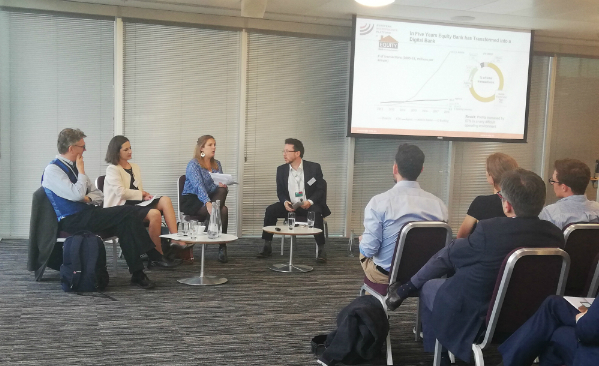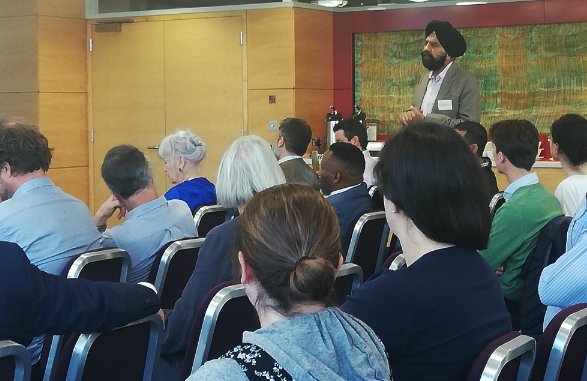 “Any sufficiently advanced technology is indistinguishable from magic”, wrote Arthur C. Clarke. Put aside cynicism about the perils of our technology-obsessed culture, focus on how communication and convenience have been changed in recent years, and then – try to imagine how transformational the current technological revolution must be for the financially excluded in low-income countries. The ability to predict the weather; contact vendors or customers; send, save, receive or borrow money affordably and immediately; find new markets – this is magical in all but name.
“Any sufficiently advanced technology is indistinguishable from magic”, wrote Arthur C. Clarke. Put aside cynicism about the perils of our technology-obsessed culture, focus on how communication and convenience have been changed in recent years, and then – try to imagine how transformational the current technological revolution must be for the financially excluded in low-income countries. The ability to predict the weather; contact vendors or customers; send, save, receive or borrow money affordably and immediately; find new markets – this is magical in all but name.
It’s happening so fast, too. The mobile phone and Internet are both barely twenty years old. The internet-connected smartphone – a tool of almost limitless utility – is half that age. What technology has done for the lives of richer consumers in the developed world may be nothing to what it can do for the financially excluded.
These were the messages at a joint e-MFP/FIF UK Offsite[1] Session held at Allen & Overy in London on 23rd May. The event was entitled Financial Inclusion through Technology – the theme of the European Microfinance Award 2018 – and served to summarise the process and takeaways of that Award (including via a launch of the new report, Digital Pathways in Financial Inclusion) and bring together a panel of experts to debate the biggest issues in the financial inclusion and technology sector.
The event began with a short slide presentation by e-MFP’s Financial Inclusion Specialist (and lead author of the report) Sam Mendelson. Sam opened with a big picture look at ‘why technology matters’: the reduced costs compared to human-intensive traditional microfinance; improvements in communications, information exchange, and the speed and reliability of financial services in remote areas; and the potential to bring into the financial ecosystem previously excluded segments – especially women, rural communities and the very poor – that brick-and-mortar MFI struggle to sustainably reach.
The innovations that make these opportunities possible are provided by a diverse range of new entrants into the rapidly-evolving financial inclusion landscape. They can offer, as Sam outlined in his introduction, an equally diverse array of technology-led products and services: credit, savings, insurance, payments or transfers, as well as institution-side delivery solutions and non-financial services.
Aurélie Wildt Dagneaux from PHB Development then gave a more detailed overview of the emergence of this new landscape, from the first microfinance institutions of 30-40 years ago to the emergence of mobile money and digital financial services for low-income groups in the last ten years, to the fintech aggregators with their exploitation of new sources of client data. So much of increased access to financial services has been driven by technology, with growth in mobile money usage far outpacing uptake of bank accounts in many markets.
Graham Wright of MSC is well known to e-MFP, most recently for his keynote at EMW 2018 in which he exhorted MFIs to ‘digitise or die!’ in the face of the threat from new entrants that risk serving only urban, high-value customers, leaving traditional MFIs with low-value rural clients in an unsustainable business model. However, Graham began on an upbeat note, with a profile of Equity Bank in Kenya, and its remarkable transformation into a digital bank, with 97% of transactions conducted outside branches and a 57% increase in profits. Also profiling what can happen when digital transformation is done well was Audrey Joubert from Advans International, and formerly of Advans Cote d’Ivoire – the winner of the EMA 2018. Audrey presented the Advans CI’s digital credit and savings initiative for cocoa farmers via cooperatives.
 There are success stories such as these, as well as cautionary tales, that exemplify what the three panelists termed the ‘necessity to digitise’. A 2015 McKinsey report predicted that MFIs that fail to transform will lose 20-60% of profits by 2025. Graham gave examples of the trends underway in some markets of digital lenders, without the core expertise in credit assessment and working with low-income segments, posing existential threats to socially-focused MFIs that are stuck in unsustainable, traditional models.
There are success stories such as these, as well as cautionary tales, that exemplify what the three panelists termed the ‘necessity to digitise’. A 2015 McKinsey report predicted that MFIs that fail to transform will lose 20-60% of profits by 2025. Graham gave examples of the trends underway in some markets of digital lenders, without the core expertise in credit assessment and working with low-income segments, posing existential threats to socially-focused MFIs that are stuck in unsustainable, traditional models.
How can this necessity be made real in practice? Aurélie introduced the ‘How to Succeed in your Digital Journey’, a six-part toolkit developed with UNCDF Microlead and Mastercard Foundation, which outlines six overlapping models for digitally transforming financial institutions. These start, as Aurélie described it, with basic operations (use of tablets for credit assessment, for example) via partnerships all the way up to mobile banking.
Partnerships are a critical part of digital transformation in financial institutions, as outlined as one of the ‘factors for success’ in Digital Pathways in Financial Inclusion. Advans CI works with various partners such as MNOs Orange and MTN, the latter which enabled Advans CI to implement its own USSD Mobile Banking menu where rural customers can check their balance and carry out transactions from their Advans account to another Advans Account. This channel (the Bank-to-Bank) is used by cooperatives to pay part of the farmers’ crops directly on their savings accounts. Advans CI also offers the farmers a wallet-to-bank and bank-to-wallet transfer service in partnership with MTN, and also offers a withdrawal card offered in partnership with SGBCI from the Société Générale Group. Finally, Advans CI received support from CGAP, both in funding to implement the mobile banking solution, and also TA from CGAP’s digital finance team, including support for a feasibility study and technical implementation of the digital school loan.
Aurélie pointed out the importance of partnerships in scaling up, pricing, and how digital transformation is an opportunity for MFIs to sustainably offer individual loans that wouldn’t be possible without efficiency increases. But there are sometimes unforeseeable consequences to such transformations: PHB has worked with MFIs where on the request of clients, they had to re-introduce the group meetings typical of the traditional microfinance model. There remains a need for the human touch and the social cohesion of group lending and savings models that can be lost in a switch to automation and branchless individual banking. Finding a way to innovate without sacrificing what clients want and need may be the biggest challenge of all.
The challenges or risks in digital transformation was the final topic for the panel. Graham is a vocal critic of some of the trends underway in the sector, including (with Kenya an example) the proliferation of consumer lenders using poor credit appraisal models (such as airtime top-ups) that lead to high write-offs, ignoring of actual client data, blacklisting of millions of clients for tiny defaults, a failure to protect consumers, endemic multiple borrowing, and barriers to mobile internet access in rural areas exacerbating the digital divide. Audrey gave examples of Advans CI’s own challenges – notably the need for financial and technological education for cash-accustomed clients in how to protect private data and safely use (and trust) mobile banking.
So what’s next? A vibrant series of questions from the audience during the panel presentations and after looked for the panellists’ ideas on what needs to be done to address the many challenges ahead. There is unanimity that in key markets, a focus on consumer finance has led to a failure to innovate in serving (M)SMEs – for which the benefits of digital finance can be the greatest. There needs to be support from other stakeholders for digitally transforming FIs, especially in disseminating best practice and helping FIs with a comprehensive digital strategy. Mobile Internet must be brought to rural, more remote clients. Finally, there needs to be a re-focus on what financial inclusion is for. Is it the Findex-type focus on bank account penetration in which there has been considerable success? Or is a focus on access making the sector miss certain blind spots and lose sight of whether technology increases the quality and value of financial services to those who need it most?
[1] Offsite Sessions are a new activity developed under our Strategic Plan 2017-2021 which take place in different e-MFP members’ countries and provide e-MFP with opportunities for more frequent touchpoints with its members and external stakeholders besides the European Microfinance Week.

Leave a comment